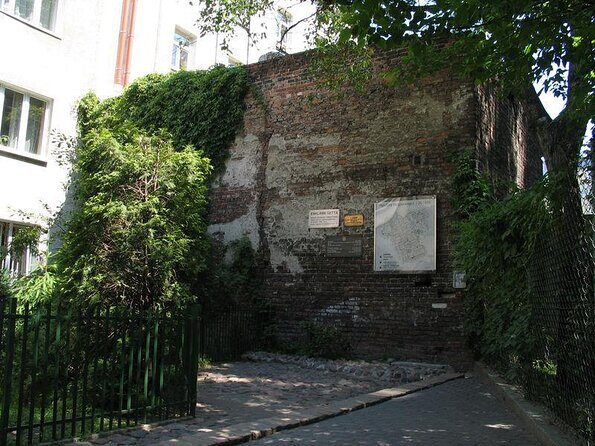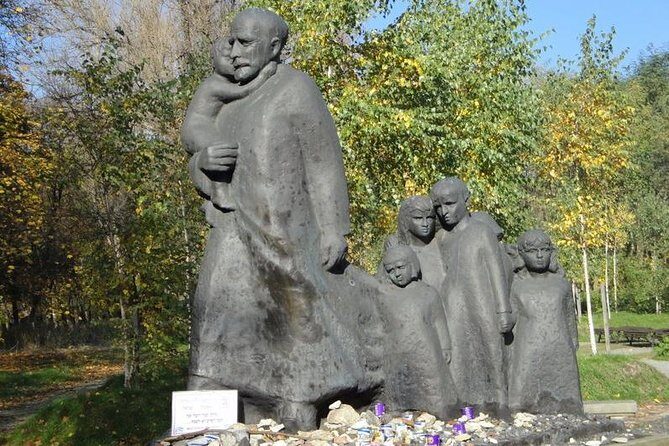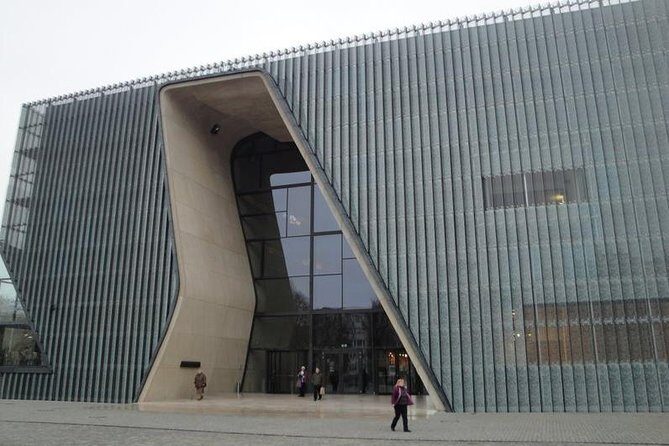Exploring Warsaw’s Jewish history in a guided tour offers a meaningful way to understand the city’s complex past. For around $270, up to four people can spend about five hours visiting significant sites like the Jewish Cemetery, the Nozyk Synagogue, and the Umschlagplatz memorial, all with the convenience of hotel pickup and drop-off. The tour is led by a knowledgeable guide, ensuring you get insightful stories and context that you might miss exploring on your own.
What we love most about this experience is how it combines the emotional weight of sites like the Ghetto Heroes monument and the Treblinka deportation site with a personal touch—thanks to the guide’s expertise and the thoughtful itinerary. Plus, seeing filming locations from The Pianist adds a cinematic dimension that can make history feel more immediate.
One thing to keep in mind is that, at $270, this tour isn’t the cheapest option available, especially considering that you need to budget for additional museum entrance fees if you wish to go inside certain sites. Also, the size of the vehicle might be small, which could be uncomfortable for those with mobility challenges or longer legs.
This tour suits travelers who value detailed storytelling and want a well-rounded introduction to Warsaw’s Jewish sites, especially if they prefer the ease of guided transportation and want to avoid the headache of planning individual visits.
- Comprehensive Itinerary: Visits to major Jewish sites like the Cemetery, Synagogue, Ghetto, and Umschlagplatz.
- Expert Guidance: Led by a highly knowledgeable guide who provides detailed stories and context.
- Convenience: Includes hotel pickup and drop-off, saving you planning time.
- Cultural & Emotional Depth: Combines history, personal stories, and cinematic locations.
- Cost & Value: Priced at $270 for a small group, with additional museum entry fees possible.
- Accessible Experience: Suitable for those with moderate physical fitness, but vehicle comfort may vary.
If you’re visiting Warsaw and want to understand its Jewish community’s history, this 5-hour tour offers a focused, insightful journey through some of the city’s most important sites. Led by Renata, a guide praised for her knowledge and personable approach, you’ll visit places like the Jewish Cemetery, the Nozyk Synagogue, the Umschlagplatz memorial, and other landmarks connected to the Jewish experience, especially during World War II.
What makes this tour stand out is how it simplifies the process of exploring Warsaw’s Jewish past. Instead of spending hours researching and trying to piece together your own itinerary, you get a curated list of must-see locations, complete with stories and context. Plus, the round-trip transport and hotel pickup make it a stress-free way to spend your day.
Two elements we particularly appreciated were the chance to see the filming locations from The Pianist—which adds a cinematic dimension to history—and the detailed explanations about the sites’ significance provided by the guide. These details make the experience both engaging and educational, especially if you’re interested in how history is reflected in culture and film.
However, the tour’s price of $270 per group may give some pause, especially when considering additional costs for entrance fees if you want to go inside certain sites like the cemetery or synagogue. The vehicle size might also be a point of discomfort for travelers who prefer more spacious transport. Still, for those who prioritize knowledgeable guides and a rundown, these are minor considerations.
This experience is ideal for history buffs, those with a personal connection to Jewish heritage, or travelers who want an authentic, guided exploration of Warsaw’s Jewish sites without the hassle of planning each detail.
An In-Depth Look at the Itinerary

Stop 1: Warsaw Ghetto
Your journey begins at the site of the former Warsaw Ghetto, which, after the 1943 uprising, was almost completely destroyed. Today, the area is marked by significant monuments, including the Rappaport monument dedicated to the heroes of the ghetto, the Mila 18 site, and the Umschlagplatz memorial. These are powerful symbols of resistance and tragedy, and Renata’s storytelling helps breathe life into these somber landmarks.
While the ghetto itself no longer exists, standing at these sites, you’ll gain a visceral sense of what it meant for thousands of Jews deported to their deaths. As one reviewer noted, “Renata took us to every Jewish site relating to World War II of significance and told their stories well,” emphasizing how her detailed narratives make history more tangible.
Interested in history? Here are other past-focused experiences we've examined in Warsaw
Stop 2: Jewish Cemetery
Next, you’ll visit the Jewish Cemetery, one of Warsaw’s most poignant sites. The preserved matzevots (gravestones) speak volumes about the community’s history, contributions, and tragedies. Here, you can learn how Warsaw’s Jewish residents influenced Polish literature, science, and arts, even amid the shadows of war and genocide. The cemetery also contains mass graves from WWII and symbolic stones honoring those murdered in Treblinka.
Bear in mind, the cemetery is closed on Saturdays, so plan your visit accordingly. The time here (about 45 minutes) allows for reflection, but also for a closer look at the inscriptions and symbols on the stones, which are often full of personal histories.
Stop 3: Umschlagplatz
One of the most emotionally charged sites, Umschlagplatz was the departure point for over 300,000 Jews from Warsaw’s Ghetto bound for Treblinka. The site now features a wall inscribed with the first 300 names of those deported, arranged alphabetically as a symbolic gesture honoring their memory.
Spending about 15 minutes here, you’ll understand the scale of deportations and the human stories behind the numbers. The wall and the quiet surroundings evoke the horror and resilience intertwined in Warsaw’s history.
Stop 4: Nozyk Synagogue
Built in the early 20th century, the Nozyk Synagogue is the only synagogue in Warsaw that survived the destruction of WWII. Today, it still functions as a place of worship, and during the Sabbath, it’s open only for prayers, making visits outside those times impossible without special arrangements.
This site symbolizes resilience, standing as a rare survivor among many Jewish buildings lost during the war. It’s a humble but meaningful stop, with stories of survival and faith woven into its history.
Stop 5: Praga Polnoc
The district of Praga offers a more intact glimpse into the Jewish past because it wasn’t as heavily bombed during the war. Here, you’ll see buildings like the former students’ dormitory where Menachem Begin, later Prime Minister of Israel, once lived. Other sites include a shelter for the poor and orphans, now a puppet theater, and a historic mikvah (ritual bath) building that survives as a school.
This part of the tour offers a more community-focused look at Jewish life, with a chance to see how some structures have been repurposed but still carry their history.
- Jewish Legacy in Warsaw. Private Tour with the best local specialist.
- Explore the Stunning Warsaw Old Town, Royal Way & Hidden Gems
- Faces of Warsaw’s 3-hour orientation city tour with hotel pick-up
- Highlights & Hidden Gems With Locals: Best of Warsaw Private Tour
- Packrafting / Kayaking Vistula River, Warsaw
- Small-Group Historical Guided Tour of Warsaw with pick up/drop off. Public Tour.
Stop 6: Jewish Historical Institute
Your last stop is the Jewish Historical Institute, housed in a building that once served as a Jewish library. The exhibit includes prewar maps of Jewish communities across Poland and archival materials from the Ghetto. The fire damage traces from the destruction of the Great Synagogue offer a stark visual reminder of what was lost, and the preserved archives provide a rare glimpse into everyday Jewish life before the Holocaust.
This stop is especially valuable for history buffs who want tangible artifacts and documents that amplify the stories told throughout the tour.
Authentic Experiences and Practical Insights
Throughout the tour, the guide’s expertise shines. As one guest said, “Renata is a wonderful and extremely knowledgeable guide. She took us to every site relating to WWII and told their stories well.” The stories are delivered with sensitivity and clarity, helping you understand why each site matters.
The round-trip hotel pickup and drop-off are a significant perk, especially in a city where public transportation can be confusing, and it saves you time and effort. The private group aspect offers an intimate experience, allowing for questions and a more personalized narrative.
While the price of $270 might seem steep, it covers not only transportation and guiding but also the convenience of a compact, well-organized itinerary. Remember, you’ll need to budget separately for entrance fees to sites like the cemetery and synagogue if you want to go inside.
The tour operates daily from 9:00 AM to 1:00 PM, making it easy to fit into a morning exploration of Warsaw. The moderate physical demand makes it accessible for most travelers, but note that some sites involve walking and standing.
Who Should Consider This Tour?

This tour is perfect for those who want a comprehensive, guided overview of Warsaw’s Jewish past without the hassle of planning each visit. History enthusiasts, those with personal or cultural connections, and travelers seeking meaningful, authentic encounters will find great value here. If you appreciate guides who can tell stories with depth and sensitivity—and want to avoid the pitfalls of a self-guided experience—this tour checks all those boxes.
However, if you’re on a tight budget or prefer exploring on your own, you might find some parts of the experience less flexible. Also, if mobility is an issue, check vehicle comfort beforehand, as some reviews suggest limited space.
FAQ

What is included in the tour?
The tour includes hotel pickup and drop-off, a driver/guide, and fuel surcharge. Entrance fees to museums are not included, so you might need to pay separately if you want to go inside sites like the cemetery or synagogue.
How long does the tour last?
Approximately five hours, giving ample time to visit all the sites comfortably.
Can I customize the sites I visit?
Since this is a private tour, you can discuss your interests with Renata beforehand to focus on specific sites or stories.
Is the tour suitable for children or those with mobility challenges?
The tour requires moderate physical activity, mainly walking and standing. Vehicle comfort might be limited, so consider your personal mobility needs.
What sites will I see?
Major sites include the Warsaw Ghetto, Jewish Cemetery, Umschlagplatz memorial, Nozyk Synagogue, Praga neighborhood, and the Jewish Historical Institute.
Are there any age restrictions?
No explicit restrictions, but due to the walking involved, younger children or those with mobility issues should plan accordingly.
How should I prepare for the tour?
Wear comfortable walking shoes, bring a camera, and prepare questions for your guide if you’re interested in deeper stories.
What makes this tour different from exploring on my own?
Having a knowledgeable guide brings history to life through storytelling, personal insights, and contextual understanding that you might miss alone.
What is the cancellation policy?
You can cancel free of charge up to 24 hours before the tour, getting a full refund.
Final Thoughts
Visiting Warsaw’s Jewish heritage sites with a guide like Renata offers a meaningful, enriching experience that combines history, culture, and remembrance. The tour’s well-organized itinerary covers key sites, providing both emotional resonance and historical context.
While the cost might be a consideration, the convenience, expert storytelling, and depth of insight offer good value for those eager to understand Warsaw’s complex Jewish legacy. For anyone interested in authentic stories and significant sites, this tour is a respectful and informative way to spend half a day.
Whether you’re a history buff, a person with personal connections, or simply curious about this pivotal aspect of Warsaw’s past, this guided experience offers a compassionate and comprehensive introduction to Jewish Warsaw.
More Historical Tours in Warsaw
- Skip-the-Line Polin Museum Warsaw Jewish History Tour
- Jewish Private Historical Tour in Warsaw
- Historic Warsaw: Exclusive Private Tour with a Local Expert
- POLIN Museum of the History of Polish Jews : PRIVATE TOUR /inc. Pick-up/
- Warsaw: Jewish Heritage & Holocaust Walking Tour
- Warsaw: Communist History Self-Driving Tour
More Tour Reviews in Warsaw
- Warsaw: Private Polish Beer Tasting Tour with a Guide
- Warsaw: Palace of Culture and Science Guided Tour
- Fryderyk Chopin and Zelazowa Wola – Half Day Tour from Warsaw by private car
- Warsaw: Old Town Highlights Private Walking Tour
- Warsaw Off The Beaten Path Self-Drive Tour
- Warsaw: Traditional Galar Cruise on The Vistula River
More Warsaw experiences we've covered
- 7 Fantastic Workshops & Classes In Warsaw
- Warsaw’s 7 Top Wine Tours (With Prices)
- Which Warsaw Walking Tours To Choose? We Rank The 16 Best
- The 9 Best Tours In Warsaw
- Top 16 Private Driver Services In Warsaw
- 5 Most Highly Rated Photography Experiences In Warsaw
- Warsaw’s 3 Top National Park Tours
- The 8 Most Popular Lunch Experiences In Warsaw
- Which Warsaw Historical Tours To Choose? We Rank The 16 Best
- Which Warsaw Full-Day Tours To Choose? We Rank The 15 Best
- The Top 12 Warsaw Food Tours
- 16 Best Drinking Tours In Warsaw (With Prices)
